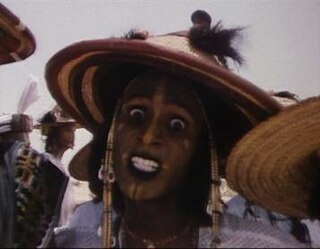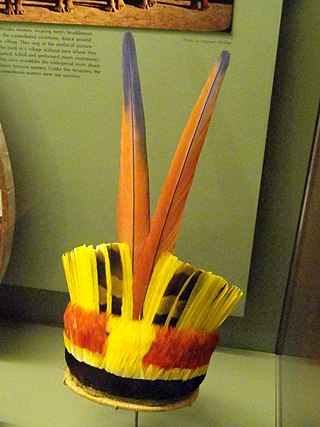Further reading
- Hampton, Christopher: "A Note on the Quarup". In: Savages, London: Faber and Faber, 1974, p.17-18
- Pedro Agostinho da Silva, Kwarup: Mito e Ritual no Alto Xingu, São Paulo, EDUSP, 1974
The Quarup or Kuarup is the principal funeral ritual of the Indigenous people of the Xingu. It is a gathering of all neighbouring tribes to celebrate life, death, and rebirth. One of its central events is the presentation of all young girls who have experienced menarche since the last quarup and whose time has come to choose a partner, they tint their bodies and wear many ornaments and dance. It is a festival for the dead.

The Xingu River is a 1,640 km (1,019 mi) river in north Brazil. It is a southeast tributary of the Amazon River and one of the largest clearwater rivers in the Amazon basin, accounting for about 5% of its water.
Act Without Words I is a short play by Samuel Beckett. It is a mime, Beckett's first. Like many of Beckett's works, the play was originally written in French, being translated into English by Beckett himself. It was written in 1956 following a request from the dancer Deryk Mendel and first performed on 3 April 1957 at the Royal Court Theatre in London. On that occasion it followed a performance of Endgame. The original music to accompany the performance was written by composer John S. Beckett, Samuel's cousin, who would later collaborate with him on the radio play Words and Music.
Orlando (1914–2002) and his brothers Cláudio (1916–1998) and Leonardo Villas-Bôas (1918–1961) were Brazilian brothers who worked in indigenous activism. In 1961 they succeeded in getting the entire upper Xingu legally protected, making it the first massive indigenous area in all South America, and the prototype for dozens of similar reserves all over the continent.
Act Without Words II is a short mime play by Samuel Beckett, his second. Like many of Beckett's works, the piece was originally composed in French, then translated into English by Beckett himself. Written in the late 1950s it opened at the Clarendon Press Institute in Oxford and was directed by John McGrath. London premiere was directed by Michael Horovitz and performed at the Institute of Contemporary Arts, on 25 January 1960. The first printing was in New Departures 1, Summer 1959.

The Kamayurá are an indigenous tribe in the Amazonian Basin of Brazil. Their name is also spelled Kamayura and Kamaiurá; it means "a raised platform to keep meat, pots and pans." The Kamayurá language belongs to the Tupi–Guarani family.

Xingu people are indigenous people of Brazil living near the Xingu River. They have many cultural similarities despite their different ethnologies. Xingu people represent fifteen tribes and all four of Brazil's indigenous language groups, but they share similar belief systems, rituals and ceremonies.

Herdsmen of the Sun is a 1989 documentary film by Werner Herzog. The film explores the social rituals and cultural celebrations of the Saharan nomadic Wodaabe tribe. Particular focus is given to the Gerewol celebration, which features an elaborate male beauty contest to win wives.
The genus Neacomys, also known as bristly mice because of their spiny fur, includes several species of rodents in the tribe Oryzomyini of family Cricetidae. It is most closely related to Oligoryzomys, Oreoryzomys, and Microryzomys. Neacomys species are mainly found in the Amazon basin, but N. pictus occurs in Panama and N. tenuipes in montane Colombia.
The Yawalapiti are an indigenous tribe in the Amazonian Basin of Brazil. The name is also spelled Iaualapiti in Portuguese. The current village Yawalapiti is situated more to the south, between the Tuatuari and Kuluene River. Their population in 2011 was 156, down from a 2010 population of 237 (2010) but up from a low of 25 in 1954.
The Kuikuro are an indigenous people from the Mato Grosso region of Brazil. Their language, Kuikuro, is a part of the Cariban language family. The Kuikuro have many similarities with other Xingu tribes. They have a population of 592 in 2010, up from 450 in 2002.
The Yudjá or Juruna are an Indigenous people of Brazil. They were formerly the major tribe along the Xingu River, but are now divided into two groups, a westernized northern group near Altamira, Para near the big bend of the Xingu and a more conservative group in the Xingu Indigenous Park at the headwaters of the Xingu in Mato Grosso. The southern group lives in two villages located near the mouth of the Maritsauá-Mitau River. They fish and raise crops, such as manioc.

The Kalapalo are an indigenous people of Brazil. They are one of seventeen tribal groups who inhabit the Xingu National Park in the Upper Xingu River region of the state of Mato Grosso. They speak the Amonap language, a Cariban language, and one of four spoken languages in the area. They have a population of 569 as of 2010.
The Aweti people are a group of Native Americans living in the Xingu Indigenous Park, close to the headwaters of the Xingu River in Brazil. The Aweti inhabit two villages in the region. One is called Tazu’jyretam, and the other is unnamed. Tazu’jyretam is the main village of the Aweti people, and has been inhabited since at least the 19th century. Tazu’jyretam also has a small port. Both of these villages are located in an area between the Curisevo and Tuatuarí rivers, which feed into the Xingu further upstream. Their population was 196 in 2011, up from 140 in 2006.
The Suyá, self-denomination Kisêdjê, are indigenous people in Brazil, at the headwaters of the Xingu River.

São José do Xingu is a municipality in the state of Mato Grosso, in the Central-West Region of Brazil.

The Waura or Wauja (waujá) are an indigenous people of Brazil. Their language, Waura, is an Arawakan language. They live in the region near the Upper Xingu River, in the Xingu Indigenous Park, and had a population of 487 in 2010.
The Yuruna languages of Brazil form a branch of the Tupian language family.

Raoni Metuktire, also known as Chief Raoni or Ropni, is an Indigenous Brazilian leader and environmentalist. He is a chief of the Kayapo people, a Brazilian Indigenous group from the plain lands of the Mato Grosso and Pará in Brazil, south of the Amazon River and along Xingu River and its tributaries. He is internationally famous as a living symbol of the fight for the preservation of the Amazon rainforest and indigenous culture.

Xingu is a 2011 Brazilian drama film directed by Cao Hamburger and scripted by him, Elena Soárez and Anna Muylaert. Starring João Miguel, Felipe Camargo and Caio Blat, the film tells the Villas-Bôas brothers trajectory from the moment in which they joined the Roncador-Xingu expedition, part of the Westward March of Getúlio Vargas, in 1943.
Hypostomus kuarup is a species of catfish in the family Loricariidae. It is native to South America, where it occurs in the Culuene River in the Xingu River basin in the state of Mato Grosso in Brazil. It is typically found in rapids within its range, although the type locality of the species has subsequently dried out due to the construction of a nearby dam. Despite this, it is still known to inhabit rapids above and below the dammed area, as well as a fish ladder built near the type locality. It is sympatric with its congener Hypostomus faveolus.